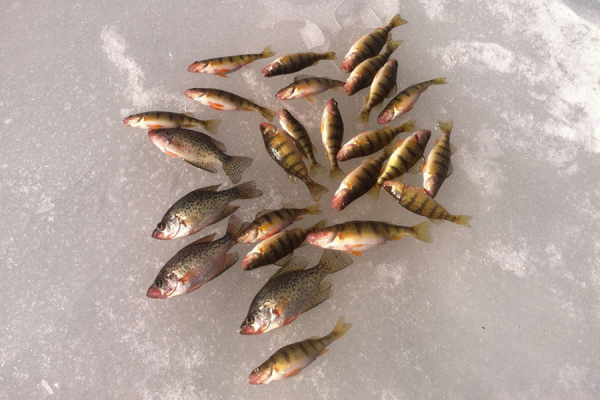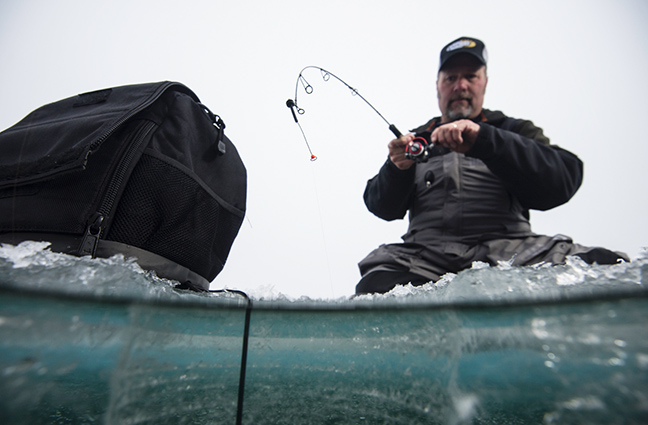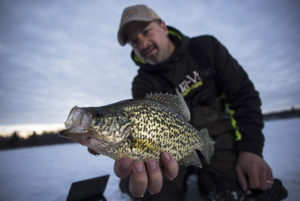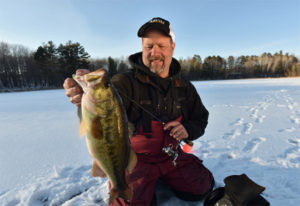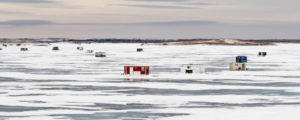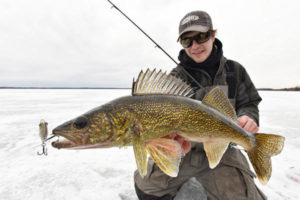Ice Fishing: Thanks for the Family Memories
Today’s feature, from the U.S. Fish & Wildlife Service, is a reminder for all in ice-fishing states that fishing “hard water” makes a great family outing, and kids who start early often pursue the sport for a lifetime.
What brings a woman — reared in the Gulf Coast of Mississippi, with the lilt of her regional roots still in her voice — to ice fish in mid-February at Minnesota’s Winona District, part of the Upper Mississippi River National Wildlife and Fish Refuge?
Yes, she’s the project leader of the refuge that touches Wisconsin, Iowa, Illinois and Minnesota. But that’s not the answer.
“It was the first winter that we lived in Wisconsin, my son was four and the refuge was offering a free clinic to introduce kids to the sport,” recalls Sabrina Chandler. “He loved it. Because when the fish aren’t biting, he could build a snowman on the ice.”
More motivating: Ice fishing is very social in a season when people can feel cooped up at home. People bring their fish cookers and it’s “kind of a party,” Chandler says. “More important than catching fish, it’s spending time outdoors.”
Chandler and her family not only go to the annual kids fishing clinic at the refuge’s Winona District, but they also take their rods – and a plain five-gallon bucket – to ice fish on their own several times a year. “We don’t bring the pop-up tents. We don’t have a big ice house,” says Chandler. “We wait for a sunny day, get out the poles and bait, fill a cooler with snacks and a thermos with hot chocolate. And we catch plenty of fish.”
Ice fishing creates family memories. Tom Wickstrom, wildlife biologist for Partners for Fish and Wildlife at Waubay National Wildlife Refuge in South Dakota, has been ice fishing since he was five years old. “I went with my dad, and he sure didn’t have to drag me!” recalls Wickstrom, who grew up in Minnesota and has been on Waubay staff since 1989.
Now he goes ice fishing often, sometimes two or three times each week “if the fish are biting.” He and his friends have a portable fish house and a heater to stay warm.
In South Dakota, the ice may be thick enough as early as Thanksgiving. It is certainly thick enough – about 18 inches to two feet – by Christmas. At Waubay Refuge, you can catch walleye, perch, northern pick and white bass. “Ice fishing is easier than other fishing because you can just walk out onto the lake, drill a hole and go fishing.”
Ice anglers coming to Waubay Refuge can park on the south side of the entrance, take fuel for their portable heaters and walk to their fishing spot. Visitors cannot drive onto the water. Visitors to Waubay Wetland Management District can also find ice fishing opportunities.
Here is a sampling of national wildlife refuges and wetland management districts where there can be great ice fishing. Restrictions vary, check with an individual refuge before you go. Year-round quality fishing opportunities are available on more than 270 national wildlife refuges. The National Wildlife Refuge System is managed by the U.S. Fish and Wildlife Service.
Arctic National Wildlife Refuge
Kenai National Wildlife Refuge
Kodiak National Wildlife Refuge
Togiak National Wildlife Refuge
Minidoka National Wildlife Refuge
Upper Mississippi River National Wildlife & Fish Refuge
DeSoto National Wildlife Refuge
Iowa Wetland Management District
Upper Mississippi River National Wildlife & Fish Refuge
Flint Hills National Wildlife Refuge
Kirwin National Wildlife Refuge
Seney National Wildlife Refuge
Shiawassee National Wildlife Refuge
Big Stone National Wildlife Refuge
Big Stone Wetland Management District
Detroit Lakes Wetland Management District
Fergus Falls Wetland Management District
Litchfield Wetland Management District
Minnesota Valley National Wildlife Refuge
Minnesota Valley Wetland Management District
Morris Wetland Management District
Rice Lake National Wildlife Refuge
Tamarac National Wildlife Refuge
Upper Mississippi River National Wildlife & Fish Refuge
Windom Wetland Management District
Benton Lake Wetland Management District
Charles M. Russell National Wildlife Refuge
Medicine Lake National Wildlife Refuge
Ninepipe National Wildlife Refuge
Pablo National Wildlife Refuge
War Horse National Wildlife Refuge
Crescent Lake National Wildlife Refuge
North Platte National Wildlife Refuge
Valentine National Wildlife Refuge
Iroquois National Wildlife Refuge
Audubon National Wildlife Refuge
J. Clark Salyer National Wildlife Refuge
Lake Alice National Wildlife Refuge
Lake Ilo National Wildlife Refuge
Long Lake National Wildlife Refuge
Tewaukon National Wildlife Refuge
Upper Souris National Wildlife Refuge
Lacreek National Wildlife Refuge
Madison Wetland Management District
Sand Lake National Wildlife Refuge
Waubay National Wildlife Refuge
Waubay Wetland Management District
Horicon National Wildlife Refuge
Trempealeau National Wildlife Refuge
Upper Mississippi River National Wildlife & Fish Refuge
The U.S. Fish and Wildlife Service works with others to conserve, protect and enhance fish, wildlife, plants and their habitats for the continuing benefit of the American people. For more information, visit www.fws.gov, or connect with us through any of these social media channels: Facebook, Twitter, YouTube and Flickr.
 Wearable ice accessories greatly increase mobility, comfort and fishing efficiency.
Wearable ice accessories greatly increase mobility, comfort and fishing efficiency. Frabill Tackle Pack/Hand Muff
Frabill Tackle Pack/Hand Muff Pictured above: Frabill’s new Ice Hunter Series Flip-Over Shelter
Pictured above: Frabill’s new Ice Hunter Series Flip-Over Shelter Pictured above: Frabill’s new Ice Hunter Finesse Spinning Combo
Pictured above: Frabill’s new Ice Hunter Finesse Spinning Combo Pictured above: XL Ice Combo Case5.
Pictured above: XL Ice Combo Case5. 